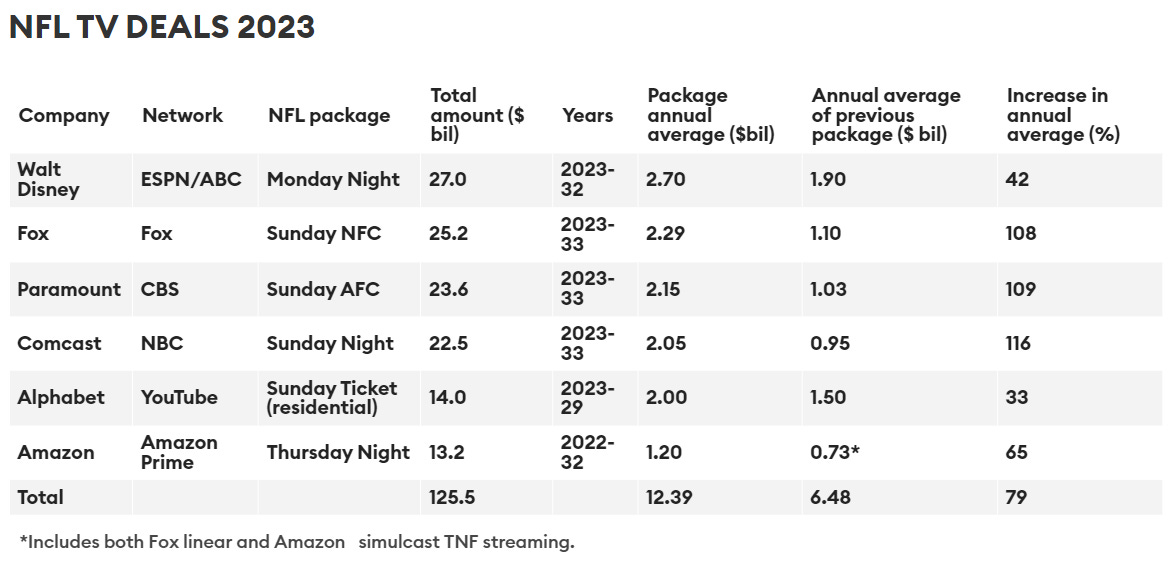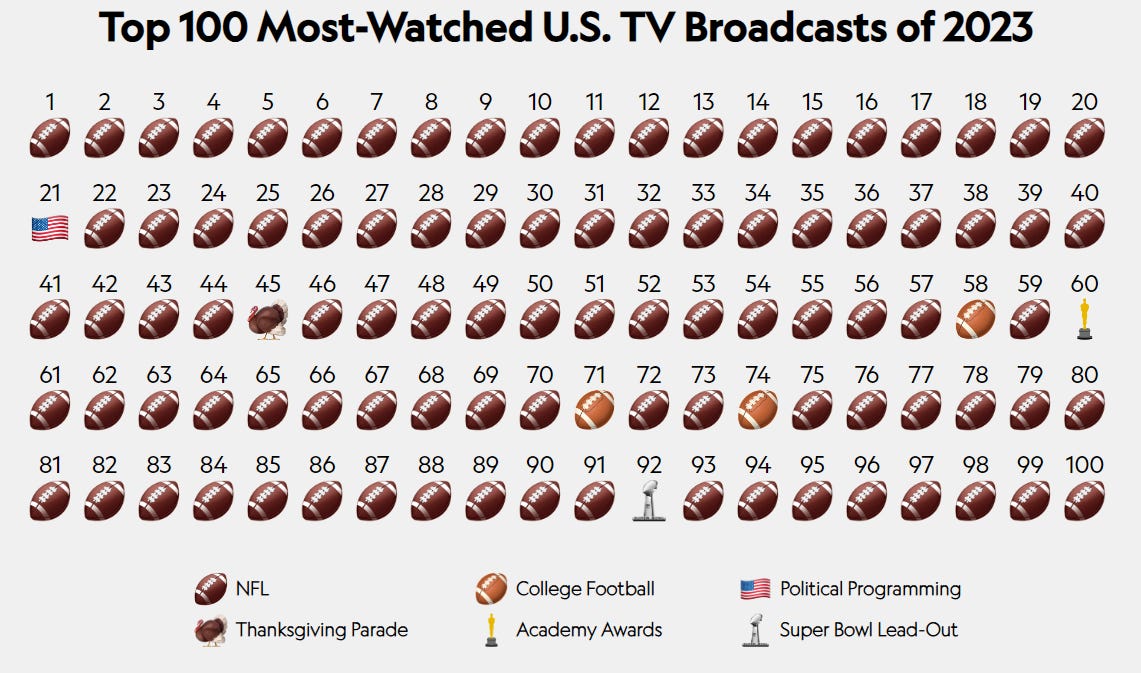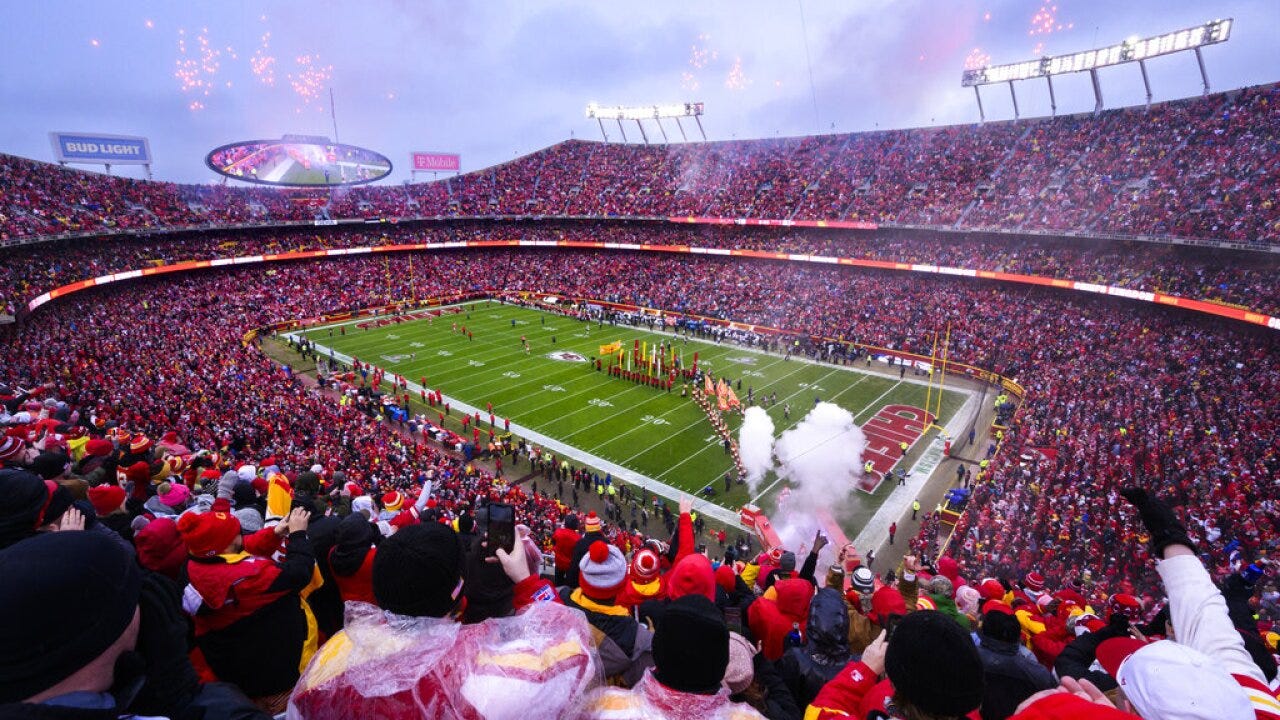Media disaggregation driven by the NFL
The NFL, the kings of monetization and American attention, lead the way in increasing media rights value through content disaggregation
TV was much better back in the day
Close your eyes, sit back and reminisce about how we used to watch our sports programming. You’d grab the remote, turn on the TV and select your country’s sports channel. It was all there, in one package, no streaming, no four different subscriptions to watch your favourite team and sports, it was just simple, comfortable, dare I say, perfect. Champions League, Premier League, Bundesliga, F1, Golf, Basketball, Ice Hockey, Tennis, all in the same sports package for a reasonable monthly fee (incomprehensible today). Fast forward to the dreaded media landscape we have to endure today. Want to watch Real Madrid, oh boy, get ready for the ride of a lifetime through everything TV has to offer. Watch them in the La Liga, maybe try beIN; want to see them in their natural habitat of the Champions League, better subscribe to Sky Sports; how about some Copa del Rey, that DAZN subscription has got you covered; heard there is another Clasico in the Supercopa Final, say hi to your latest friend Moviestar+ (illustrative example).
Think it could not get anymore confusing? Enter, the NFL. Last Saturday the NFL and Peacock (NBC’s streaming service) aired the first exclusively streamed NFL playoff Game between the Miami Dolphins and the Kansas City Chiefs, who have the league’s best and most prolific player in Patrick Mahomes. A collective sigh could be heard across the US, as millennials realized they had to explain to their dads what Peacock is, how to download it and set up a profile. As a fellow millennial, whose family still has not fully recovered from the technological miracle of showing holiday photos on the TV via apple TV’s screen mirroring, this sounds like absolute nightmare fuel.
Today, we explore why the NFL would do something like this, confusing and antagonizing a fanbase with an average age of 47, as well as what this Game signifies in the greater context of TV rights disaggregation and what it indicates for the future.
Source: AP
What is all the fuss about?
More and more, sports media rights are being sold in packages, allowing multiple broadcasters to buy up individual packages, leading to the disaggregation evident in today’s market. Take the Bundesliga’s domestic media rights of the Bundesliga, for instance:
Sky (Pay-TV): 200 Saturday games
DAZN (Pay-TV/SVOD1): 106 Games across Friday and Sunday
ProSiebenSat.1 (Free-to-air): 9 live games per season
It becomes evident from this, that a German fan wanting to follow every game of their favourite team will have to pay for both Sky and DAZN, and potentially need to watch a game on German Free-TV. The Bundesliga is not alone in this; most popular leagues today sell their rights in similarly fragmented packages, which leads to this disaggregation that is not to any fans liking.
If disaggregation is counter to the fan experience, the very individuals essential to the survival of any sports, then why do leagues do this? As with most things in the sports industry, the answer is money! By splitting the rights into smaller, more affordable packages, leagues attract a broader array of broadcasters to come to the table and bid.
This increased competition for limited TV rights packages inflates the value of these individual packages, boosting the overall total revenue for the rights holder, aka the leagues. The broadcasters, wanting to recoup their investment, usually charge for the access to their channels/platforms to watch these exclusive games they have acquired. Blinded by our love for the sport and our teams, we as fans often reluctantly fork over the required monthly fee even for multiple offerings to happily continue watching our favourite teams play.
How does the NFL exactly play into this?
The NFL is the king of rights disaggregation and revenue generation from their media rights. It outperforms all other leagues globally in annual revenue, collecting a gigantic $12.4bn from media rights alone, and total revenues of $18.6bn (the NBA being the next closest at $10.6bn annually). The NFL has broadcasting partnerships covering the entire media gambit, from Free-to-air with Fox, CBS, NBC, to Pay-TV with ESPN and streaming with YouTube and Amazon Prime. It is a perfectly oiled money-making machine the NFL has created with its TV rights deals. They even have the Superbowl on a 4-year rotation between its major broadcasters FOX, CBS, NBC, and ESPN (previously 3-year, excl. ESPN), with CBS showing this year’s Superbowl on 11 February.
Source: Forbes
This level of success inevitably sparks envy among other leagues, prompting them to try and replicate the NFL’s successful disaggregation strategy. Most notable, the NBA in the midst of negotiating its next media rights deal from 2025 onwards, tries to follow the same playbook, expanding from its current 2 partnership deal with ESPN and TNT to more broadcaster (preferably deep-pocketed tech companies eager to bolster their streaming offering), even creating a new in-season tournament this year that will obviously be sold as an individual package to a lucky broadcaster.
The controversy that angered millions of Football fans on the weekend arose when the NFL decided to let NBC stream the highly anticipated playoff game between the Dolphins and the Chiefs exclusively on NBC’s streaming service, Peacock. NBC paid a handsome fee of $110m to the NFL for the exclusive streaming rights to this playoff game, a first. Some might argue that Thursday Night Football (TNF) has been exclusively available on Amazon’s Prime Video streaming service for two seasons, but to be fair, that is a bit different, given that basically everyone already has an Amazon Prime subscription in the US (~170m Amazon Prime members in the US) that grants access to TNF. Peacock by contrast only has around 30m subscribers in the US. To many fans’ delight, they had the pleasure of subscribing to Peacock for one month at minimum, and then also helping their parents figure out how to do that. And, surprise surprise, Peacock does not have a free trial month available, so $5.99 at checkout it was for the honour of a 1-month Peacock subscription. Quite the nuisance, especially when you are accustomed to seeing every playoff game on free-TV.
Did the gamble pay off?
Was it worth it for the NFL to provoke all this confusion and anger amongst its fanbase for what basically amounted to a minor drop in the bucket in its overall media rights revenue ($110m is less than 1% of the annual package value)? How about for NBC?
For NBC in the short-term, this was definitely a cash-burning endeavour, with the hope to recoup that investment by converting some of the subscriber influx into long-term paying customers. The NFL angle is far more interesting here from a broader sports media rights perspective. Looking at the Playoff wildcard weekend viewership numbers across all games, it appears that the NFL and NBC lost out on a vast number of viewers on the Peacock game:
Of note here as well is that the Peacock game was on Saturday evening prime time TV, making these numbers look even worse. It was the least watched game by a at least 5.6million viewers, and this with some of the biggest superstar names playing as well, in Patrick Mahomes (the best player in the NFL), Travis Kelce (of Taylor Swift fame; also a top-3 Tight End of all time) and Tyreek Hill (probably the most entertaining wide-receiver to watch in the game). As a contrast, let’s look at the viewership figures of Chiefs playoff games from the last two years (granted one is a 2023 Divisional Round, but it still gives an indication). The Chiefs are definitely an entertaining watch that normally attracts more viewers:
2023 Divisional Round: Jacksonville Jaguars at Kansas City Chiefs – 34.1million viewers
2022 Wildcard Round: Pittsburgh Steelers at Kansas City Chiefs – 29.7million viewers
However, the Peacock game did become the most streamed event in US history, which does not hold much weight at all. It is an NFL playoff game; it would have been more of a surprise if it had not broken any streaming records. 93 out of the 100 most watched US TV broadcasts last year were football games, which in and of itself is a mindboggling number, so anything else then record numbers would have been a complete flop.
Source: Sportico
From an NFL perspective the viewership figures were never really the focal point (unless they would have completely cratered). This streaming exercise was a clear showcase to the market, especially the tech companies with streaming services, what the NFL is preparing for the next media rights cycle. This was a peak into the future, where further disaggregation will be inevitable, given the NFL’s desire to continue growing its revenues. They showed the streamers that they are willing to stream playoff games exclusively, which they will definitely offer in some form of package deal. While we as fans might scream with outrage at the thought of further disaggregation, it is inevitable that we will have to prepare ourselves for a viewing experience with more and more Games locked behind exclusive paywalls, even though the NFL has built its empire upon access and creating the largest following of fans in the US. Expect other leagues to test the waters as well, with the NFL acting as the industry behemoth and leader behind which the others follow. Disaggregation will become more prevalent on all fronts in sports unfortunately, due to its revenue generating power.
The NFL will continue to push the boundaries further, even to the chagrin of its fans, as long as they can count on them coming back and continuing to watch every week, which will probably not change anytime soon. I am just saying…..93 out of 100.
One random fact
The Dolphins vs. Chiefs game shown on Peacock was the 4th coldest game ever played in the NFL, at a cool -20*C (-4 Fahrenheit), with wind chill of -33*C (-27 Fahrenheit)
Media rights expert certificate, check!
This brief crash course into the world of sports media rights and their disaggregation highlighted why it so frequently occurs and why the hell you need countless different subscriptions to watch your favourite team and sport. Even if it kind of sucks for sports fans, I hope you have a better appreciation for the strategic thinking and the business rationale behind media rights disaggregation.
If you have enjoyed this breakdown, please consider sharing it with your friends and subscribing, much appreciated!
Source: AP
SVOD: Subscription video on demand








